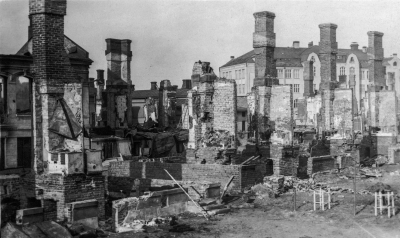The Battle of Lnkipohja (Finnish pronunciation: [lkipohj]) was a Finnish Civil War battle fought in the village of Lnkipohja (now part of the Jms municipality) on 16 March 1918 between the Whites and the Reds. Together with the battles fought in Kuru, Ruovesi and Vilppula between 15 and 18 March, the Battle of Lnkipohja was one of the first military operations related to the Battle of Tampere, which was the decisive battle of the Finnish Civil War. The battle is known for its bloody aftermath as the Whites executed 70100 capitulated Reds. One of the executions was photographed and the images have become one of the best known pictures of the Finnish Civil War.
The Finnish Civil War was a civil war in Finland in 1918 fought for the leadership and control of the country between White Finland and the Finnish Socialist Workers' Republic (Red Finland) during the country's transition from a grand duchy of the Russian Empire to an independent state. The clashes took place in the context of the national, political, and social turmoil caused by World War I (Eastern Front) in Europe. The war was fought between the "Reds", led by a section of the Social Democratic Party, and the "Whites", conducted by the conservative-based senate and the German Imperial Army. The paramilitary Red Guards, which were composed of industrial and agrarian workers, controlled the cities and industrial centers of southern Finland. The paramilitary White Guards, which consisted of land owners and those in the middle- and upper-classes, controlled rural central and northern Finland, and were led by General C. G. E. Mannerheim.
In the years before the conflict, Finland had experienced rapid population growth, industrialisation, pre-urbanisation and the rise of a comprehensive labour movement. The country's political and governmental systems were in an unstable phase of democratisation and modernisation. The socio-economic condition and education of the population had gradually improved, and national thinking and cultural life had increased. World War I led to the collapse of the Russian Empire, causing a power vacuum in Finland, and the subsequent struggle for dominance led to militarisation and an escalating crisis between the left-leaning labour movement and the conservatives. The Reds carried out an unsuccessful general offensive in February 1918, supplied with weapons by Soviet Russia. A counteroffensive by the Whites began in March, reinforced by the German Empire's military detachments in April. The decisive engagements were the Battles of Tampere and Vyborg, won by the Whites, and the Battles of Helsinki and Lahti, won by German troops, leading to overall victory for the Whites and the German forces. Political violence became a part of this warfare. Around 12,500 Red prisoners died of malnutrition and disease in camps. About 39,000 people, of whom 36,000 were Finns, died in the conflict.
In the immediate aftermath, the Finns passed from Russian governance to the German sphere of influence with a plan to establish a German-led Finnish monarchy. The scheme ended with Germany's defeat in World War I, and Finland instead emerged as an independent, democratic republic. The civil war divided the nation for decades. Finnish society was reunited through social compromises based on a long-term culture of moderate politics and religion and the post-war economic recovery.
The Finnish Civil War of 1918 was the second civil conflict within Finland's borders, as the Cudgel War of 1596-1597 (where poor peasants rose up against the troops, nobles and cavalry who taxed them) has similar features.

1918Mar, 16
Finnish Civil War: Battle of Länkipohja is infamous for its bloody aftermath as the Whites executed 70-100 capitulated Reds.
Choose Another Date
Events on 1918
- 3Mar
World War I
Russia signs the Treaty of Brest-Litovsk, agreeing to withdraw from World War I, and conceding German control of the Baltic States, Belarus and Ukraine. It also conceded Turkish control of Ardahan, Kars and Batumi. - 2May
Chevrolet Motor Company
General Motors acquires the Chevrolet Motor Company of Delaware. - 24Jun
Montreal
First airmail service in Canada from Montreal to Toronto. - 4Jul
Nicholas II of Russia
Bolsheviks kill Tsar Nicholas II of Russia and his family (Julian calendar date). - 9Nov
Wilhelm II, German Emperor
Kaiser Wilhelm II of Germany abdicates after the German Revolution, and Germany is proclaimed a Republic.

 English
English  español
español  français
français  português
português  русский
русский  العربية
العربية  简体中文
简体中文 